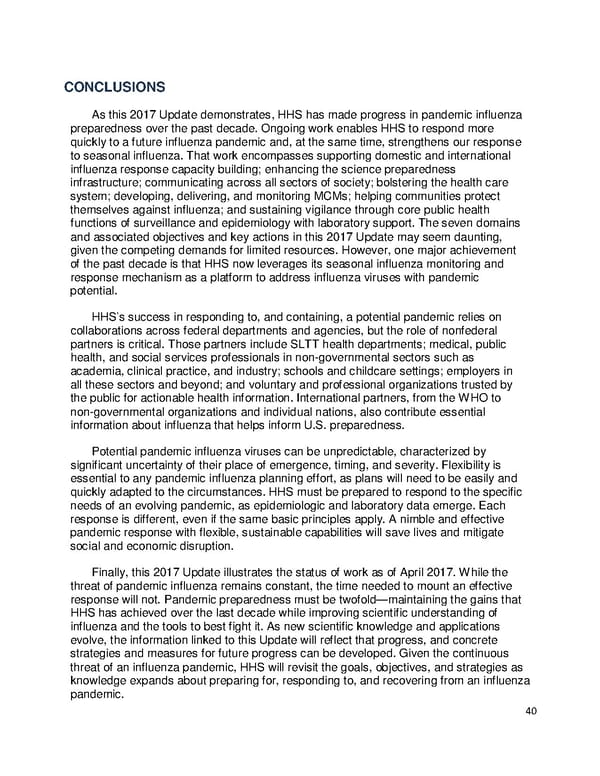CONCLUSIONS As this 2017 Update demonstrates, HHS has made progress in pandemic influenza preparedness over the past decade. Ongoing work enables HHS to respond more quickly to a future influenza pandemic and, at the same time, strengthens our response to seasonal influenza. That work encompasses supporting domestic and international influenza response capacity building; enhancing the science preparedness infrastructure; communicating across all sectors of society; bolstering the health care system; developing, delivering, and monitoring MCMs; helping communities protect themselves against influenza; and sustaining vigilance through core public health functions of surveillance and epidemiology with laboratory support. The seven domains and associated objectives and key actions in this 2017 Update may seem daunting, given the competing demands for limited resources. However, one major achievement of the past decade is that HHS now leverages its seasonal influenza monitoring and response mechanism as a platform to address influenza viruses with pandemic potential. HHS’s success in responding to, and containing, a potential pandemic relies on collaborations across federal departments and agencies, but the role of nonfederal partners is critical. Those partners include SLTT health departments; medical, public health, and social services professionals in non-governmental sectors such as academia, clinical practice, and industry; schools and childcare settings; employers in all these sectors and beyond; and voluntary and professional organizations trusted by the public for actionable health information. International partners, from the WHO to ividual nations, also contribute essential non-governmental organizations and ind information about influenza that helps inform U.S. preparedness. Potential pandemic influenza viruses can be unpredictable, characterized by significant uncertainty of their place of emergence, timing, and severity. Flexibility is essential to any pandemic influenza planning effort, as plans will need to be easily and quickly adapted to the circumstances. HHS must be prepared to respond to the specific needs of an evolving pandemic, as epidemiologic and laboratory data emerge. Each response is different, even if the same basic principles apply. A nimble and effective pandemic response with flexible, sustainable capabilities will save lives and mitigate social and economic disruption. Finally, this 2017 Update illustrates the status of work as of April 2017. While the threat of pandemic influenza remains constant, the time needed to mount an effective response will not. Pandemic preparedness must be twofold—maintaining the gains that HHS has achieved over the last decade while improving scientific understanding of influenza and the tools to best fight it. As new scientific knowledge and applications evolve, the information linked to this Update will reflect that progress, and concrete strategies and measures for future progress can be developed. Given the continuous threat of an influenza pandemic, HHS will revisit the goals, objectives, and strategies as knowledge expands about preparing for, responding to, and recovering from an influenza pandemic. 40
 Pandemic Influenza Plan Page 39 Page 41
Pandemic Influenza Plan Page 39 Page 41